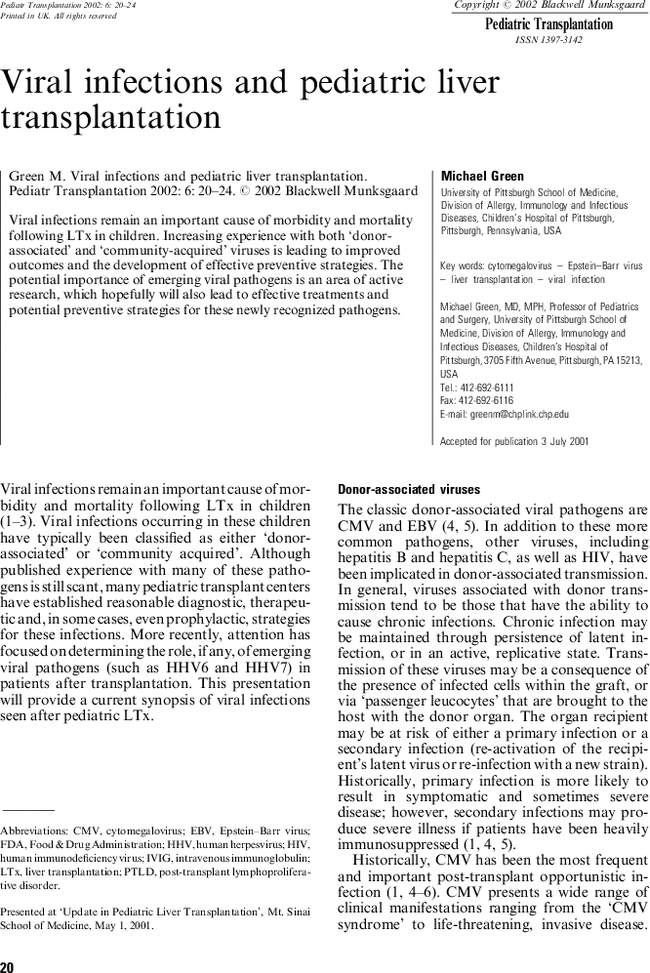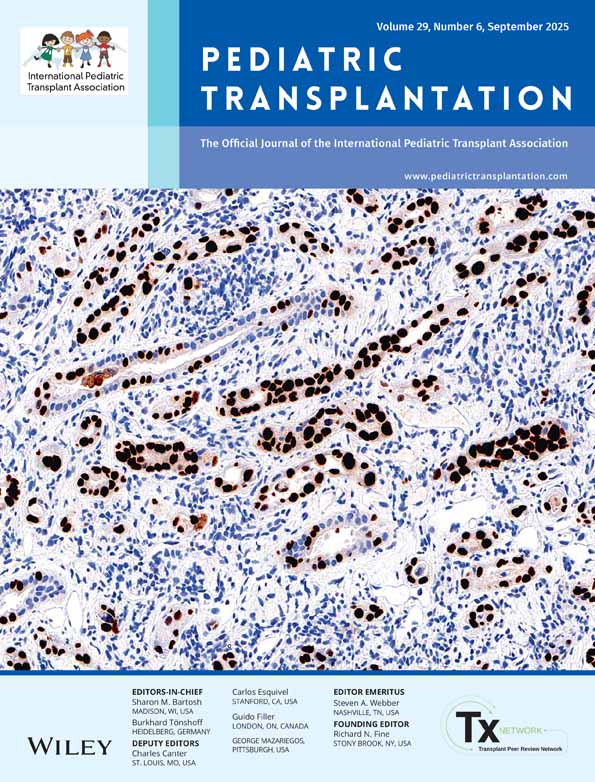Viral infections and pediatric liver transplantation
Michael Green,
Michael Green
University of Pittsburgh School of Medicine, Division of Allergy, Immunology and Infectious Diseases, Children's Hospital of Pittsburgh, Pittsburgh, Pennsylvania, USA
Search for more papers by this authorMichael Green,
Michael Green
University of Pittsburgh School of Medicine, Division of Allergy, Immunology and Infectious Diseases, Children's Hospital of Pittsburgh, Pittsburgh, Pennsylvania, USA
Search for more papers by this authorMichael Green, MD, MPH, Professor of Pediatrics and Surgery, University of Pittsburgh School of Medicine, Division of Allergy, Immunology and Infectious Diseases, Children's Hospital of Pittsburgh, 3705 Fifth Avenue, Pittsburgh, PA 15213, USA
Tel.: 412-692-6111
Fax: 412-692-6116
E-mail: [email protected]

References
- 1 Green M, Michaels M. Infectious complications after solid-organ transplantation. Adv Pediatr Infect Dis 1992: 6: 181–204.
- 2 Bouchut JC, Stamm D, Boillot O, Lepape A, Floret D. Postoperative infectious complications in paediatric liver transplantation: A study of 48 transplants. Paediatr Anaesth 2001: 6: 93–98.
- 3 Green M, Tzakis A, Reyes J, Nour B, Todo S, Starzl TE. Infectious complications of pediatric liver transplantation under FK506. Transplant Proc 1991: 6: 3038–3039.
- 4
Breinig MK,
Zitelli B,
Starzl TE,
Ho M.
Epstein–Barr virus, cytomegalovirus, and other viral infections in children after liver transplantation.
J Infect Dis
1987: 6: 273–279.
10.1093/infdis/156.2.273 Google Scholar
- 5 Singh N, Dummer S, Kusne S, et al. Infections with cytomegalovirus and other herpesviruses in 121 liver transplant recipients: Transmission by donated organ and the effect of OKT3 antibodies. J Infect Dis 1988: 6: 202–206.
- 6
Stratta RJ,
Shaefer MS,
Markin RS, et al.
Clinical patterns of cytomegalovirus disease after liver transplantation.
Arch Surg
1989: 6: 1443–1450.
10.1001/archsurg.1989.01410120093018 Google Scholar
- 7 George MJ, Snydman DR, Werner BG, et al. Use of ganciclovir plus cytomegalovirus immune globulin to treat CMV pneumonia in orthotopic liver transplant recipients. Transplant Proc 1993: 6 (Suppl. 4): 22–24.
- 8 Green M, Kaufmann M, Wilson J, Reyes J. Comparison of intravenous ganciclovir followed by oral acyclovir with intravenous ganciclovir alone for prevention of cytomegalovirus and Epstein–Barr virus disease after liver transplantation in children. Clin Infect Dis 1997: 6: 1344–1349.
- 9 Sia IG, Wilson JA, Groettum CM, Espy MJ, Smith TF, Paya CV. Cytomegalovirus (CMV) DNA load predicts relapsing CMV infection after solid organ transplantation. J Infect Dis 2000: 6: 717–720.
- 10 The TH, Van Der Ploeg M, Van Der Berg A, Vlieger AM, Van Der Giessen M, Van Son WJ. Direct detection of cytomegalovirus in peripheral blood leukocytes – a review of the antigenemia assay and polymerase chain reaction. Transplantation 1992: 6: 193–198.
- 11 Green M, Michaels MG, Webber SA, Rowe D, Reyes J. The management of Epstein–Barr virus associated post-transplant lymphoproliferative disorders in pediatric solid-organ transplant recipients. Pediatr Transpl 1999: 6: 271–281.
- 12 Paya C, Fung JJ, Nalesnik MA, et al. Epstein–Barr virus-induced post-transplant lymphoproliferative disorders. Transplantation 1999: 6: 1517–1525.
- 13 Rowe DT, Qu L, Reyes J, et al. Use of quantitative competitive PCR to measure Epstein–Barr virus genome load in peripheral blood of pediatric transplant recipients with lymphoproliferative disorders. J Clin Microbiol 1997: 6: 1612–1615.
- 14 Riddler SA, Breinig MC, McKnight JLC. Increased levels of circulating Epstein–Barr virus-infected lymphocytes and decreased EBV nuclear antigen antibody responses are associated with the development of posttransplant lymphoproliferative disease in solid-organ transplant recipients. Blood 1994: 6: 972–984.
- 15 Kenagy DN, Schlessinger Y, Weck K, Ritter JH, Gaudreault-Keener MM, Storch GA. Epstein–Barr virus DNA in peripheral blood leukocytes of patients with post-transplant lymphoproliferative disease. Transplantation 1995: 6: 547–554.
- 16 Milpied N, Vasseur B, Parquet N, et al. Humanized anti-CD20 monoclonal antibody (Rituximab) in post transplant B-lymphoproliferative disorder: a retrospective analysis of 32 patients. Ann Oncol 2000: 6 (Suppl.): S113–S116.
- 17
Pohl C,
Green M,
Wald ER.
RSV infection after pediatric liver transplantation.
J Infect Dis
1992: 6: 166–169.
10.1093/infdis/165.1.166 Google Scholar
- 18
Apalsch AM,
Green M.
Influenza and parainfluenza virus infections in pediatric organ transplant recipients.
Clin Infect Dis
1995: 6: 394–399.
10.1093/clinids/20.2.394 Google Scholar
- 19 Fitz SW, Green M, Reyes J, et al. Clinical features of nosocomial rotavirus infection in pediatric liver transplant recipients. Clin Transpl 1995: 6: 201–205.
- 20
Saez-Llorens X,
Castano E,
Null D, et al.
Safety and pharmacokinetics of an intramuscular humanized monoclonal antibody to respiratory syncytial virus in premature infants and infants with bronchopulmonary dysplasia. The MEDI-493 Study Group.
Pediatr Infect Dis
1998: 6: 787–791.
10.1097/00006454-199809000-00007 Google Scholar
- 21
Michaels M,
Green M,
Wald ER,
Starzl TE.
Adenovirus infection in pediatric orthotopic liver transplant recipients.
J Infect Dis
1992: 6: 170–174.
10.1093/infdis/165.1.170 Google Scholar
- 22 Green M, Michaels M. Adenovirus. Parvovirus B19 and papillomavirus in transplant infections. In: Bowden RA, Ljungman P, Paya C, eds. Transplant Infections. Philadelphia: Lippincott-Raven Publishers, 1998: 6 287–294.
- 23 Bergen GA, Sakalosky PE, Sinnot JT. Transient aplastic anemia caused by parvovirus B19 infection in a heart transplant recipient. J Heart Lung Transplant 1996: 6: 843–845.
- 24 Nour B, Green M, Michaels M, et al. Parvovirus B19 infection in pediatric transplant patients. Transplantation 1993: 6: 835–838.
- 25 Chang FY, Singh N, Gayowski T, Mariono IR. Parvovirus B19 infection in a liver transplant recipient: case report and review in organ transplant recipients. Clin Transplant 1996: 6: 243–247.
- 26 Kurtzman GJ, Ozawa K, Cohen B, Hanson G, Oseas R, Young NS. Chronic bone marrow failure due to persistent B19 parvovirus infection. N Engl J Med 1987: 6: 287–294.
- 27 Janner D, Bork J, Baum M, Chinnock R. Severe pneumonia after heart transplantation as a result of human parvovirus B19. J Heart Lung Transplant 1994: 6: 336–338.
- 28 Kurtzman GJ, Cohen B, Meyers P, Ammunullah A, Young NS. Persistent B19 parvovirus infection as a cause of severe chronic anaemia in children with acute lymphocytic leukemia. Lancet 1988: 6: 1159–1162.
- 29 Kurtzman GJ, Frickhofen N, Kimball J, Jenkins DW, Nienhuis AW, Young NS. Pure red-cell aplasia of 10 years' duration due to persistent parvovirus B19 infection and its cure with immunoglobulin therapy. N Engl J Med 1989: 6: 519–523.
- 30 Mendez JC, Dockrell DH, Espy MJ, et al. Human beta-herpesvirus interactions in solid-organ transplant recipients. J Infect Dis 2001: 6: 179–184.
- 31 Humar A, Malkan G, Moussa G, Greig P, Levy G, Mazzulli T. Human herpesvirus-6 is associated with cytomegalovirus reactivation in liver transplant recipients. J Infect Dis 2000: 6: 1450–1453.
- 32 Yoshikawa T, Ihira M, Furukawa H, et al. Four cases of human herpesvirus 6 variant B infection after pediatric liver transplantation. Transplantation 1998: 6: 1266–1269.
- 33 Yoshikawa T, Ihira M, Suzuki K, et al. Human herpesvirus 6 infection after living related liver transplantation. J Med Virol 2000: 6: 52–59.




